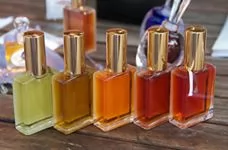How to Verify Natural Perfumes and Identify Authentic Scents
December 31st, 2024 by JoAnne Bassett
Natural perfumes have an allure like no other. They whisper secrets of flowers, roots, and resins rather than shouting chemical concoctions. Yet, with clever marketing and misleading labels, it’s easy to fall prey to imposters. Let this guide be your lantern in the fog as we explore how to uncover the truth behind your scents.
The Importance of Knowing How to Verify Natural Perfumes
Imagine standing in a bustling marketplace. Vendors call out their wares, claiming their goods to be genuine. One offers you a bottle labeled “natural perfume.” It smells divine, but can you trust it? The stakes aren’t just about being duped; they’re about your health and connection to nature.
Synthetic fragrances often contain phthalates and other toxic chemicals that can irritate skin or disrupt hormones. True natural perfumes, on the other hand, consist only of botanical extracts and essential oils. By learning how to verify natural perfumes, you ensure that what you wear is safe for both your body and the environment.
Subtle Clues: Reading Labels Like a Detective
The first step in identifying natural perfumes is simple: read the label with care. Authentic brands don’t hide their ingredients—they celebrate them. Look for terms like “essential oil,” “botanical extract,” or “organic.” Avoid products listing vague terms like “fragrance” or “parfum,” which often signal synthetic formulas.
But labels can be tricky; they’re designed to sell a dream. Some companies use words like “natural-inspired” or “nature-identical,” which sound convincing but mean nothing in terms of authenticity. If you see these phrases without a clear ingredient list, walk away.
Trust Your Nose: The Scent Test
Natural perfumes tell stories through their scents—stories that evolve over time. Synthetic fragrances tend to hit you all at once with overpowering notes that remain static. A natural perfume unfolds like chapters in a book: the top notes greet you lightly before fading into heart notes that linger warmly on your skin, eventually settling into deep base notes.
Here’s an experiment: spray a sample on your wrist and wait 15 minutes. Does it change? Does it breathe? If it feels alive and layered, chances are you’ve found something real.
Certifications: The Seal of Approval
When in doubt, look for certifications from trusted organizations like USDA Organic. These seals aren’t just decorative stamps; they’re proof that the product meets strict standards for natural ingredients.
Keep in mind that smaller artisanal brands may not always have these certifications—they can be expensive for small businesses—but they often provide transparency about sourcing and production methods. Don’t hesitate to ask questions; authentic makers love sharing their craft.
Red Flags That Signal Synthetic Scents
– Overly bright colors in liquid form (natural perfumes rarely have neon hues).
– Long ingredient lists filled with unfamiliar chemical names.
– Prices that seem too good to be true (quality comes at a cost).
Conclusion: Trust Nature’s Whisper
In a world where synthetic scents shout from every corner, learning how to verify natural perfumes is an act of quiet rebellion—a way to reconnect with nature’s essence. It’s about more than smelling good; it’s about honoring what’s real.
So next time you pick up a bottle, remember this guide. Be curious, ask questions, trust your senses, and seek out transparency. The journey may take more effort than grabbing the first perfume off the shelf—but when you find that authentic scent, it’ll feel like standing in those lavender fields at sunset once again.